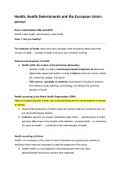Health, Health Determinants and the European Union
EPH1021
Part I: Introduction PBL and EPH
Health, public health, and European public health
Case 1: Are you healthy?
The definition of health: there have been paradigm shifts throughout history about the
concept of health → concept of health is dynamic and constantly evolving
Historical development of health:
● Health within the context of Ancient Greek philosophy:
○ Aristotle: health is a state of well-being/complete happiness (Eudaimonia)
○ Hippocrates argues that health is a state of balance of the four humour (black
bile, yellow bile, phlegm, and blood)
○ 16th century - paradigm in medicine: development of studies in anatomy
and medicine made pathology, microbiology, and disease the dominant
domains of health
Health according to the World Health Organisation (1948):
State of complete physical, mental, and social well-being and not merely absence of disease
or infirmity
● Implies three dimensions of health: social and mental health are considered and not
just physical/biological disease
● Criticism: definition too utopian (established after WWII) → operationalism of health
becomes difficult due to the breadth of the definition, “complete state” → is well-being
the same as health? → contributes to the medicalization of health
Health according to Dubos:
Health is an expression of the extent to which individuals and social groups maintain in
readiness those resources necessary to meet the exigencies of the future.
● Implies health is a word applied to individuals/groups when they have
physical/mental resources to achieve their objectives
,Health according to Huber:
Ability to adapt and self-manage, in the face of social, physical, and emotional challenges -
● Based on the concept of positive health → health is not seen as a state (WHO) but
as an ability to cope → health is not in the domain of only healthcare professionals
but everyone (the public)
● Huber’s health dimensions: 1.) body functions 2.) mental functions/perceptions 3.)
spiritual dimension 4.) life quality 5.) social participation 6.) daily functioning
● Criticism: health is complex and dynamic but reduced to six fixed dimensions →
behaviour and health are not distinguished clearly
Antonovsky and salutogenesis: approach of human health examining factors contributing
to promotion and maintenance of physical and mental well-being rather than disease
Theory of Communicative Action by Jürgen Habermas:
Objectivity: what is reliably true? → institution within society: science
Intersubjectivity: what is moral and good? → institution within society: law
Subjectivity: what is preferable? → institution within society: art
, Case 2: The ‘Public’ of (European) Public Health
The meaning of public health is contested: we cannot define public health without
identifying what a public health problem would look like → these problems are diverse:
● Epidemiological issue: an increasing health problem in a population
● Causation issue: socio-economic and background conditions lead to health inequity
● Responsibility issue: collective/governmental health action, not on a individual level
● Polity issue: forms of intervention needed as health problem threatens society
Definition of public health: science and art of preventing disease, prolonging life, and
promoting health through organised efforts of society (Acheson 1988)
● Primarily concerned with the health of entire populations rather than individual health
● Government intervention (at times the public itself) is a major aspect of public health
● Reliance on data and empirical quantitative assessment
● Multidimensional and interdisciplinary field of knowledge involving complex
interactions of biological, psychosocial, and environmental factors
● Population health: health outcomes of groups of individuals, not intervention
Normative or descriptive dimensions of public health:
● Acheson’s definition is descriptive → about social activities aiming to promote health
● Winslow and the Institute of Medicine definitions are partly normative → ascribe
responsibilities to the community and society’s obligation
The two meanings of public within ‘public health’:
● Public as population: public can be used to refer to the health of a group of
individuals hence the relevance of epidemiology → collective health
● Public as intervention: public within public health does not refer to the state of
health of a population, but rather the set of interventions and actions aimed to protect
the health of the public → collective intervention
Public as a population Public as space for action Public as a set of values
As a population, the public As a space for action, we As a set of values, the public
becomes a statistical entity of become the space that we becomes shared and
groups of individuals that can improve by acting upon that collectivised values we as a
be analysed for information in space through the space community strive for, good life
development of public health (public acts, through itself onto quality, security, equality are
knowledge itself to improve itself) supported universally





